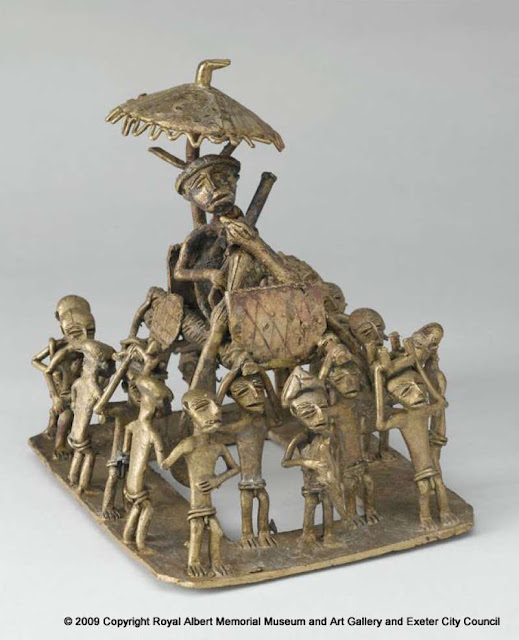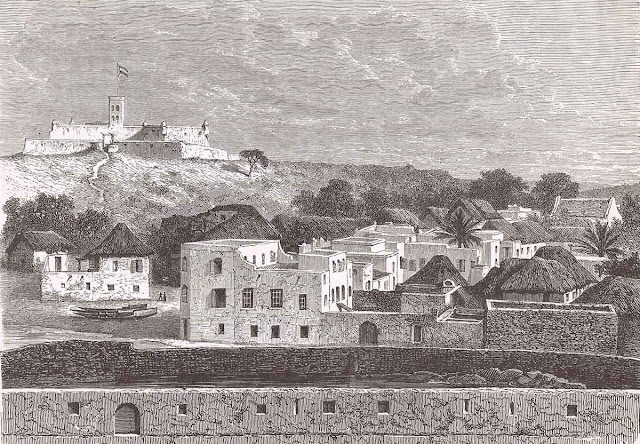A trade in children?
As indicated in the last blog, the number of child-servants, especially boys, seems to have been considerable, when we judge their presence at the courts of Europe and in well-to-do families from available paintings and records. And as there has been no structured research into the issue as yet, the true character of the presence of African children in Europe in the seventeenth and eighteenth century can not be properly interpreted as yet.
By extension, we do not know if there was, for instance, some sort of parallel (slave) trade for young children, directly from the the coast of West Africa to Europe, and if so how this was organised and executed. Also, we can not be sure - as indicated before - about the social position of these children
as interpreted contemporeneously. It is obvious that they were seen in a different light than the chattel slaves destined for the plantation colonies in the West Indies. But in what way they may have been seen differently is not clear.
To organise our thoughts around this issue we can look at three cases involving the procurement of children in the Dutch possessions on the Coast of Guinea. All three are from the period that also saw Presto being sent to the Netherlands. We know about these cases, because there were financial and administrative issues, which caused them to be recorded in the administration. The first two are of a general nature, the third one brings us close to Presto and Fortuin.
Case 1: Two boys in Accra
In 1744, the commandant of Dutch Accra, Balthazar Coymans, bought 'two negro boys, named Sacresi and Aquambuni.' Payment was in kind, namely an exchange for 'two male slaves.'
The case is interesting, because of several
elements. In the first place, the transaction clearly indicates how the children were procured, namely in a monetary transaction. Also interesting is that the value of the boys, whose age is unknown, was equal to that of two adult male slaves destined for the plantations. Although no values are mentioned, this seems a high value, and indicates a bonus value for children who were not being sent to the plantations.
Interesting too is the fact that the two boys, although obviously
enslaved, had their own (local) names, and were identified by these. However, the
phonetic rendering of the names in script and probably also pronuciation make
them difficult to recognise as local Akan or Ga names, or names from any neighbouring languages.
The fate of the boys was unrecorded. They are not mentioned in Coymans's estate, which was recorded after his death in 1748. The inventory of the estate does mention a large number of slaves, however, who were apparently meant to be transported to the West Indies. The report and references can be found
here.
Case 2: Children as gift for Curacao
The second case is linked to a crisis in the slave trade of the Dutch West India Company (W.I.C.) after the revocation in the 1730s of the monopoly this Company had. For a while, W.I.C. officials were allowed to trade in slaves privately and sell the enslaved persons they procured in West Africa either to the W.I.C. or to private traders. For several reasons, including abuse of the system, this privilege was fully revoked in 1745.
One of the abuses occurred around 1742-1743. It was in effect a tax evasion scheme set up by, or with the full assistance of Jacob de Petersen, the director-general or governor-in-chief of the Dutch Gold Coast from 1740 to 1747. For each enslaved person traded privately, a sales tax or 'recognition' had to be paid to the the W.I.C. In the 1740s the W.I.C. made a last effort to trade a large number of slaves to Curacao for their own account. The officials in Ghana, with the active support and official endorsement of director-general De Petersen, took this opportunity to send considerable numbers of African people to Curacao as 'gift' to friendly parties on that Carribean island. The scheme was intricate, as De Petersen let the possibility open for the W.I.C. to levy tax afterwards, shielding his position somewhat.
What is striking is that it concerned young people mainly: boys and girls. The records show that they were not intended to work on the plantations, but were directed towards the households of the named receivers, who were - obviously - not to pay for them. So at face value, one could see a comparison with the children directly sent to Europe here.
 |
| 'IDP [...] tot een Vereeringe zijn gegeven geworden Neegen Negermeijsjes daerom alle fraude te vermijden zijn gemerkt met een bijsondere merk als in margine [...]' |
On the other hand, when we look closely at the administration of the transport of these children given as gifts, the patterns are much closer to the trade of chattel slaves for the plantations: there is a value put on them by the ship's captains, and what is more, they were all branded with the mark of the person who sent them (the 'sellers'). In one special case, it was Jacob de Petersen himself who had his mark 'IDP' put on the bodies of a group of nine girls, as token that it concerned an 'official' and not a commercial transaction, and 'to avoid all fraud.'
And last but not least, for these children sent to Curacao, we cannot say in what circumstances they came to live. Differently from the children ending up in Europe, the ones going to Curacao ended up in a slave society. So we might surmise that for all intends and purposes they were socially and legally slaves like all others. In Europe the African children found themselves in total social dependence, but legally they had the same rights as everybody else.
An overview of the original records (in Dutch) can be found
here.
Case 3: Two boys in Elmina
The third case also involved Jacob de Petersen, as the man who may or may not have been directly involved in the transfer of Presto from Africa to the Netherlands, and to which effect this case discussed here may hold the key.
In 1744, two local parties in the town of Elmina had a conflict over the death of a man named 'Coerantje.' The cause of his death could not be properly established, so neither could the question be answered whether it was a matter of foul play (murder, manslaughter) on the part of one of the parties. Arbitrage had taken place under the supervision of director-general De Petersen, and it was decided to settle the case with compensation. The wronged party - the family of the killed man - received, in accordance with local custom, a compensation in the form of 'two benda merchandise and two negro boys.'
 |
| 'Soude werden gegeeven Twee Bende Coopmanschappen en Twee Neger Jongens [...]' | | |
|
Two benda, or four ounces, of merchandise represented a value of 152 guilders in 1744 coin. The value of the boys is unclear. The merchandise was paid to the wronged party through the hands of Jacob de Petersen. For the boys, the guilty party handed over two so-called 'impias,' a pawn or security. In this case this was most likely an amount of gold, which one could not sell or use, but had to be kept until the original debt was paid.
The question is now what actually happened with the boys. No follow-up records were as yet found to shed light on this. One could consider the following though:
- Jacob de Petersen was heavily involved in the case, as arbiter, and agent for the transfer of the compensation.
- The guilty party handed the impias over directly, but was this also the case with the boys? Or could this have gone through De Petersen again?
- Is it possible that De Petersen kept the boys for himself in exchange for the value of the security?
- Could the two boys thus procured have been taken to the Netherlands by Jacob de Petersen in 1747? And could we then recognise them in the gift to Princess Carolina as Presto and Fortuin?
Details of this case, including a transcription (in Dutch only) and references to the original records, can be found
here.
Considerations
The three cases, lead to the following general considerations:
- On the West African side children who were bought and sold in the same manner as chattel slaves for the plantation economies of the West Indies.
- There seems to be a premium set on the price of (some) children, considering the boys from case 1 had the same value as an adult enslaved male.
- Children that went to the West Indies were treated in the same manner as all chattel slaves, including their defacement with a branded mark indicating their seller. For the children that went directly to Europe, it is uncertain if they were branded. In the case of Presto / Christiaan we have a personal description from a German police report, which recorded as 'special mark' only the fact that he was 'a Moor.' Which was obviously a main characteristic of his fysique, but unfortunately leaves us in the dark about the question whether he was branded or not.
- Children could be part of local transactions in Ghana, connected with local (legal) systems of compensation. This indicates that children who were in a dependent position could change hands in another manner than trade.
The general involvement of W.I.C. officials in the acquisition, handling (and trading) of children in Ghana confirms the image from our last blog: there was a special interest in African children parallel to the general Atlantic slave trade servicing the plantation economies of the West Indies. The how and why is a yet not completely clear, and questions remain about the way in which these children were regarded and treated.
With our focus on the 1740s, the period Presto came to the Netherlands, we have some indications that the powerful director-general Jacob de Petersen might have been the agent involved in his migration to the Netherlands. We will return to this topic in the next blog.










































